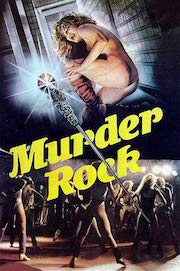
(1984,It/US)
(aka SLASHDANCE / GIALLO A DISCO / MURDEROCK - UCCIDE A PASSO DI DANZA / THE DEMON IS LOOSE)

starring: Olga Karlatos, Ray Lovelock, Claudio Cassinelli, Cosimo Cinieri, Guiseppe Mannajuolo, Belinda Busato, Maria Vittoria Tolazzi, Geretta Giancarlo, Christian Borromeo, Robert Gligorov, Carlo Caldera, Riccardo Parisio Perrotti, Giovanni De Nava
- Lt Borges tells it how it is.
[review by JA Kerswell]
Welcome to the ironically named Arts for Living Center – where the students have to pay in sweat – and blood! And where no one will live forever …
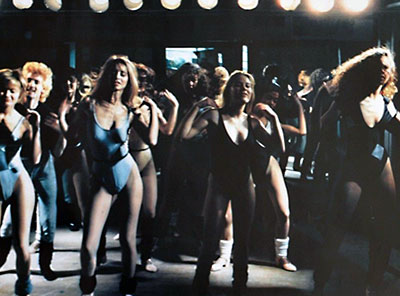 |
|
| Legs akimbo in MURDER-ROCK: DANCING DEATH. |
With echoes of Dario Argento’s SUSPIRIA (1977), and its ballet school setting, MURDER-ROCK: DANCING DEATH features young dancers at a New York City academy that has an almost sci-fi’esque security system complete with a room housing a wall of monitors and an announcement system bizarrely similar to Mother in Ridley Scott’s ALIEN (1979). They are training hard under the hard-ass direction of Candice Norman (Olga Karlatos – best remembered for her eyeball skewering in Fulci’s seminal ZOMBIE (1979)). Candice, we discover, can no longer dance and can only teach after being injured in a motorcycle accident some years before. She is assisted by a pre-DEMONS (1985) Geretta Geretta (as Margie), who disagrees with her aggressive approach. Candice is training the dancers mercilessly for an upcoming show but is concerned to discover it has been bumped forward two weeks by a seemingly omnipresent academy director called Dick (Claudio Cassinelli). She tells him that the students will do anything for a part in the show. “There’ll be trouble, Dick. I guarantee you!”, she says in something of an understatement. “If the kids find out they’ll tear each other to shreds!”
A young couple, Susan (Angela Lemerman) and Willy (Christian Borromeo) stay behind after practice to canoodle. Susan skips to the showers naked apart from her legwarmers (how 1984!); only to be apprehended by a mystery assailant who chloroforms her and then pierces her naked chest with and ornate hat pin (resulting in only the merest trickle of blood).
Susan’s body is quickly discovered; leading to a rapid police investigation under the watch of Lt Borges (Cosimo Cinieri). Borges is stereotypically boorish and displays little sympathy for the remaining dancers and staff at the academy. He confides to his colleague that: “[this is …] a dance school full of sons of bitches!” He is convinced that the killer is amongst their ranks: “Have you considered the possibility of a possible paranoid amongst you that hates dancers and has decided to do you all in?”, he says with characteristic sensitivity. Candice seemingly has no time for sensitivity either. Putting on her best Debbie Allen impression she tells the students “You have to grit your teeth and dance – even when a friend dies!” – then makes them perform like horses trotting!
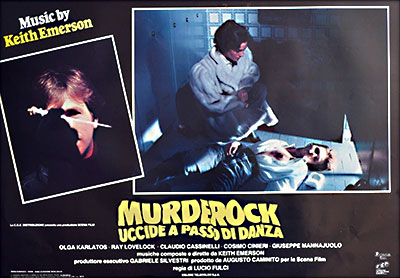 |
|
| Italian promotional material for MURDER-ROCK: DANCING DEATH. |
The student body ending up in body bags isn’t Candice’s only problem. Dick has told her he intends to bed most of her remaining female students – to which she just shrugs. But what really concerns her are the dreams of being pursued by a figure (Ray Lovelock) sporting black gloves and an ornate hat pin. In her nightmares he murders her. It all seems so real that she goes looking for him (as you do) and finds that he is a down-on-his-luck model called George Webb living in a seedy hotel. In a typically illogical step she embarks on an affair with him. But it seems that George has something to hide (we already saw him lurking behind some Venetian blinds ogling the dancers earlier in the film) – and one of the girls clearly already knows him and enthusiastically greets him as George Glass (bizarrely Jan Brady’s imaginary boyfriend in THE BRADY BUNCH!).
With legwarmers-no-panties Susan out of the way, it means that there is one less competitor for the big show. However, the killer hasn’t put away his or her hat pin just yet …
Today, when the words Lucio Fulci are spoken talk of gouged eyeballs, razored breasts, drilled heads and vomited up intestines are sure to follow. Fulci was perhaps the undisputed King of Pasta Splatter. The man who had spilt more stage blood that possibly any other director. That said, anyone going into MURDER-ROCK: DANCING DEATH cold may be surprised. There’s no geysers of blood. In fact, there’s so little of the red stuff on display that you might need a magnifying glass to spot it. But if Fulci was uncharacteristically restrained (even his earlier Westerns and Historical dramas featured graphic violence) there’s enough of his trademarks here to entertain once you realise what you’re getting into. And what you’re getting is an off-the-wall US-set giallo that spends as much time on bouncing butts in lycra (that 1984 obsession) as it does on its central mystery. Part of the fun, also, is spotting a veritable who’s-who of Italian genre cinema throughout.
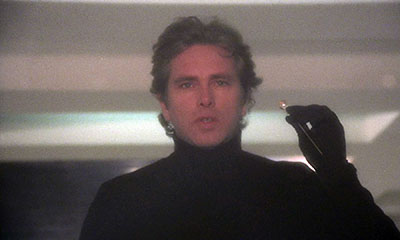 |
|
| Ray Lovelock is the killer in MURDER-ROCK: DANCING DEATH - or is he? |
However, the lack of gore isn’t the only problem in Fulci’s MURDER-ROCK: DANCING DEATH. Overall it is very much a mixed bag of disappointments and tepid delights. The film was clearly made to capitalise of the success of FAME (both the 1980 movie and perhaps more specifically the popular TV series that ran from 1982-1987) and especially Adrian Lyne’s FLASHDANCE (1983). Lyne’s highly stylised film had the look throughout of a high-end pop video. Fulci follows suit (although this approach was hardly unusual in mid-late 80s Italian gialli). However, he hammers home the point by shamelessly ripping off a scene from FLASHDANCE when a dancer performs for an audience on stage under a shower of water. It is curious as to why Fulci chose not to go the full exploitation route for his film by eschewing explicit violence for an approach that might not be out-of-place in an episode of MURDER SHE WROTE – reportedly he instructed Giuseppe Pinori to shoot in the style of a slick TV movie (although the frequent topless nudity would have kept this off the small screen in many territories). Also, Fulci eschews most of the slasher tropes popular at the time. Curiously, although presumably made with the US market in mind (with the boffo stateside box office of ZOMBIE a not too distant memory), strip away the mid-80s North American stylings and this is unmistakably an Italian giallo with one eye back to the heyday of the early 1970s. It was as if he was straddling the past and the future unsure of which direction to take. Ultimately settling on the familiar in an effort to hold off what was fast becoming apparent was the collapse of the Italian horror movie as any kind of major cinematic force. MURDER-ROCK: DANCING DEATH is often regarded as the last of Fulci’s decently budgeted movies and arguably the faded swansong of his heyday. The film was supposed to be the start of a new trilogy (KILLER SAMBA and THRILLING BLUES were the mooted follow-ups). The lukewarm financial response to MURDER-ROCK: DANCING DEATH nixed these coupled with Fulci’s failing health, which took him out of action for a couple of years. By the time he returned to the director’s chair in 1986, with THE DEVIL’S HONEY, the writing was very much on the wall for Italian cinema – and, along with such contemporaries as Dario Argento and especially Sergio Martino, budgets began shrinking, TV beckoned and projects became harder to realise – at least on the scale they had enjoyed throughout the 1970s and early 1980s.
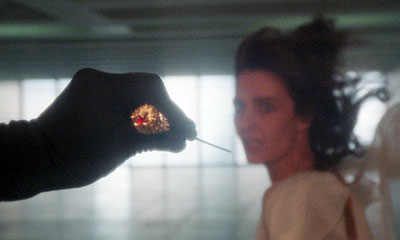 |
|
| Careful, Olga. You'll have your eye out! |
It could be argued that much of Fulci’s 1980s canon veered towards incoherence at times. Perhaps something easier to forgive in his esoteric zombie trilogy of the early 1980s than the giallo, which usually relies on intricate – albeit often outrageous – plotting to succeed. There is ultimately a fuzzy logic of kinds at play here, but there are plot holes big enough to drive a bus full of eager dancers doing jazz hands out the windows through. The killer’s motive is solid (as crazy giallo motives go), but there is no particular reason the murders start when they do. Several characters just vanish from the action without explanation and many act in frankly bizarre ways – including one who taunts the police with tapes seemingly confessing to the killings as a joke although they have nothing to do with it at all; another who tries to justify turning up at a murder scene of a babysitter saying he was picking up his date; and another who dons the killer’s disguise (even though they have no way of knowing what it looks like). Still, everyone is a suspect in a giallo and characters veering from seeming hero to pantomime villain and back again is all part of the zany charm of the genre.
Fulci seems duty bound to shoehorn in as many scenes as possible of nubile young things frugging in lycra to Keith Emerson’s bouncy score (Emerson had previously provided the score for Dario Argento’s INFERNO (1980)). Which, whilst fun for a while, only serve to grind the action and suspense to an absolute halt. However, aided by the excellent cinematography of Giuseppe Pinori, it looks great – especially the moody shots of the New York skyline at winter sunset. Fulci also orchestrates some arresting visual sequences – with standouts being a panning shot of a body being wheeled passed sobbing students; the hypnotic, jerky scene where the killer is seemingly taunted by playback of the murder victims dancing on the security TV screens and the slo-mo dream sequence with Lovelock pursuing Karlatos, which is reminiscent of the visual psychedelia of his earlier giallo LIZARD IN A WOMAN’S SKIN (1971).
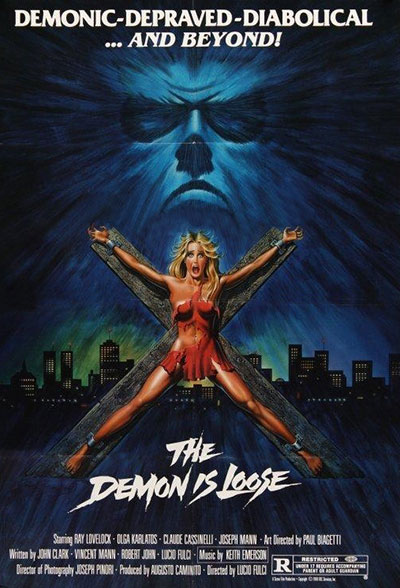 |
|
| The outrageously misleading US 1 sheet for the film's belated theatrical release in 1990. |
As I mentioned before, MURDER-ROCK: DANCING DEATH is a veritable candy box of recognisable genre actors. Christian Borromeo might be best remembered as the baby-faced sidekick in Argento’s TENEBRE (1982). Here he bows out soon after a nonsensical scene where he appears in the apartment of a soon-to-be-murder-victim only to seemingly vanish into thin air moments later as she’s being offed. Rumoured clashes with Fulci on set might have been to blame. Cosimo Cinieri, as Lt Borges, continues the long running giallo in-joke of a policeman-with-quirk (here his incessant munching on candied nuts). Cinieri was something of a Fulci regular at this time – also appearing in his earlier NEW YORK RIPPER and MANHATTAN BABY (both 1982). He gets all the best lines, too. Seeing a photo of the suspect he quips: “The killer is pretty natty, he’s wearing an Armani jacket!” The taker of the photo is Silvia Collatina, who plays a girl in a wheelchair being babysat by one of the ill-fated dancers (Collatina gave a memorable turn as the ghost child in Fulci’s HOUSE BY THE CEMETERY (1981)). The handsome Ray Lovelock had appeared in several earlier genre films (including Tonino Cervi’s remarkable QUEENS OF EVIL (1970)). By 1984 he was working almost exclusively in TV, so it was good to see him appearing in a feature – and in his only collaboration with Fulci. Claudio Cassinelli, as the sleazy Dick, passed away the following year in 1985. He was also a regular genre actor and had appeared in the likes of WHAT HAVE THEY DONE TO YOUR DAUGHTERS (1974) and THE SUSPICIOUS DEATH OF A MINOR (1974). Robert Gligorov played Danny and went on to a role in Michele Soavi’s STAGEFRIGHT (1987) – he subsequently went on to a successful career as an artist famed for his shocking and grotesque work. Fulci himself plays his regular cameo – here as a waspy talent agent who tries to warn Candice about George.
The shooting dates for MURDER-ROCK: DANCING DEATH vary depending on which sites you look at, but it seems that production took place between December 1983 and February 1984. Location shooting took place in New York City with interior scenes shot back in Italy at the Incir De Paolis Studios in Rome. Dialogue was shot in English. Articles appeared in the Italian press about Emersen’s involvement with the soundtrack and was obviously seen as a selling point (although Fulci reportedly hated it). And, you may want to don earplugs for the particularly tuneless power ballad that smothers the first couple of minutes (if you’re so inclined the soundtrack was released on Bubble Records).
Apparently, the script was partially inspired by A TIME OF PREDATORS (the 1969 American crime novel by Joe Gores). However, the only aspect loosely borrowed was a subplot concerning a female rape victim who seeks vengeance by pushing a hat pin into the hearts of would be attackers. Fulci includes a scene in the film where a female character is shown reading a paperback copy of the novel.
Fulci reportedly complained that the film’s producers had forced him to turn the film into a “musical” (which it isn’t really in the truest sense). FLASHDANCE had been the number one film at the Italian box office in 1983, which explains the urgent attempts to ape its success at least visually. Of course, this producer meddling doesn’t mitigate the blame for the film’s muddled and sometimes incomprehensible script. This may have had something to do with the fact that four different people (including the director himself) are credited for the screenplay/story (including previous Fulci collaborators Roberto Gianviti (A LIZARD IN A WOMAN’S SKIN, DON’T TORTURE A DUCKLING (1972) and THE PSYCHIC (1977)) and Vincenzo Mannino (THE NEW YORK RIPPER).
At the time, Fulci expressed his opinion that the days of ultra-violent horror films were over. He may have been burnt by the stinging criticism of THE NEW YORK RIPPER and/or been mindful of delivering less graphic (and presumably more saleable) films because of the increasing puritanism and censorship that was prevailing at the time of the so-called ‘video nasties’ hysteria. It is ironic then that this ‘softer’ Fulci flick never got a UK release.
The film was released as MURDEROCK: UCCIDE A PASSO DI DANZA (which translates roughly as MURDEROCK: HE KILLS AT A DANCE PACE) to Italian screens in Italy throughout the summer of 1984 and into 1985, after passing the Italian censor board (easily I’d imagine) in April 1984. However, it made little impact at the box office failing to make the Top 100 of the year. Ironically, given the slavish attempts to bow to the obsessions of 1984 (aerobics, break dancing and leg warmers) the film didn’t get a theatrical release in the US until 1989 through 1990 under the thoroughly misleading title of THE DEMON IS LOOSE. It must have looked positively antiquated by then. Predictably, the critics were not particularly enthused. Joe DeChick was one of the few reviewers to comment on the film. In the June 11 1990 edition of The Cincinnati Enquirer, he said: “There is no demon in Demon, only a serial killer shoving needles into the chests of nubile New York City dance students.” He continued: “How bad is this theater-clearer? A dozen brave souls filed in for a Friday night showing but only one stayed until the end. Guess who?” The misleading title may have been explained due to it playing as a second feature with the EXORCIST III (1990) in some areas. Unusually, the film didn’t get a US VHS release (although it did in other territories including Australia). A small mystery is its oft quoted alternative title of SLASHDANCE (supposedly the English language European release). I’ve not seen any evidence that this ever existed and it’s possible that it is being confused with the 1989 film of the same name by James Shyman.
Full disclosure: I knew it had to happen one day. After 20+ years and 400+ reviews I’ve accidentally reviewed a film that was already on the site! Albeit I didn’t write the original review for MURDER-ROCK: DANCING DEATH. Read Bengt Wallman’s original from 2004 here.
 female: 5 / male: 0
female: 5 / male: 0